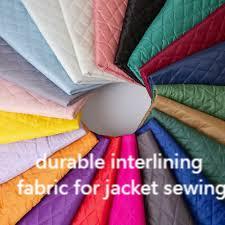In modern apparel development, Interlining serves as the unsung hero that elevates both the look and functionality of clothing. By sitting discreetly between the visible fabric and lining, Interlining reinforces seams, shapes collars, and imbues each piece with lasting structure. Although it remains out of sight, its impact on fit, drape, and durability is profound, transforming everyday garments into long‑wearing style statements.
Reinforcing Structural Integrity
Behind the scenes, carefully chosen support layers empower designers to craft garments that maintain their shape through wear and care. By adding subtle stiffness where needed—such as on lapels, cuffs, and plackets—these internal components prevent sagging and misshapen edges. Tailors rely on this reinforcement to achieve crisp silhouettes without adding noticeable bulk, ensuring that jackets, dresses, and shirts retain professional lines over time.
Streamlining Production with Heat‑Activated Bonding
Advancements in adhesive technology have streamlined the manufacturing process. Heat‑activated materials bond swiftly to the outer fabric when pressed, eliminating tedious stitching and reducing labor costs. This method not only speeds up assembly but also ensures uniform adhesion, preventing peeling or shifting. As a result, production lines can maintain higher throughput while delivering consistent quality across thousands of units.
Balancing Comfort and Performance
While structure is vital, wearer comfort cannot be compromised. Modern engineering blends support fibers with breathable weaves that allow air circulation and moisture wicking. In activewear and performance gear, this balance keeps garments lightweight and flexible, letting individuals move freely without restriction. By integrating functional layers that adapt to body temperature and motion, apparel engineers meet consumer demands for both style and practicality.
Adapting to Diverse Fabric Types
Not all textiles behave the same way, and support solutions must be tailored accordingly. Lightweight weaves require equally light‑weight reinforcement to preserve delicacy, whereas heavy outer fabrics benefit from sturdier backing to withstand stress. Whether crafting silk blouses, denim jackets, or technical outerwear, manufacturers select inner layers that match fabric weight, elasticity, and end‑use requirements, achieving optimal cohesion between materials.
Embracing Sustainable Textile Practices
Environmental responsibility has become a key driver in component selection. Bio‑based adhesives, recycled fibers, and solvent‑free bonding techniques are rising in popularity. Producers are investing in low‑impact processes that minimize water and energy use while reducing waste. By choosing green materials and closed‑loop manufacturing, brands and suppliers work together to lower the carbon footprint of each garment without sacrificing performance or quality.
As fashion continues to evolve, these concealed support layers will remain essential to creating garments that look impeccable, perform reliably, and respect environmental goals. For a deeper exploration of material types, application methods, and innovation in hidden textile components, visit
https://www.interlining-factory.com/news/what-is-interlining-types-applications-and-more.html



